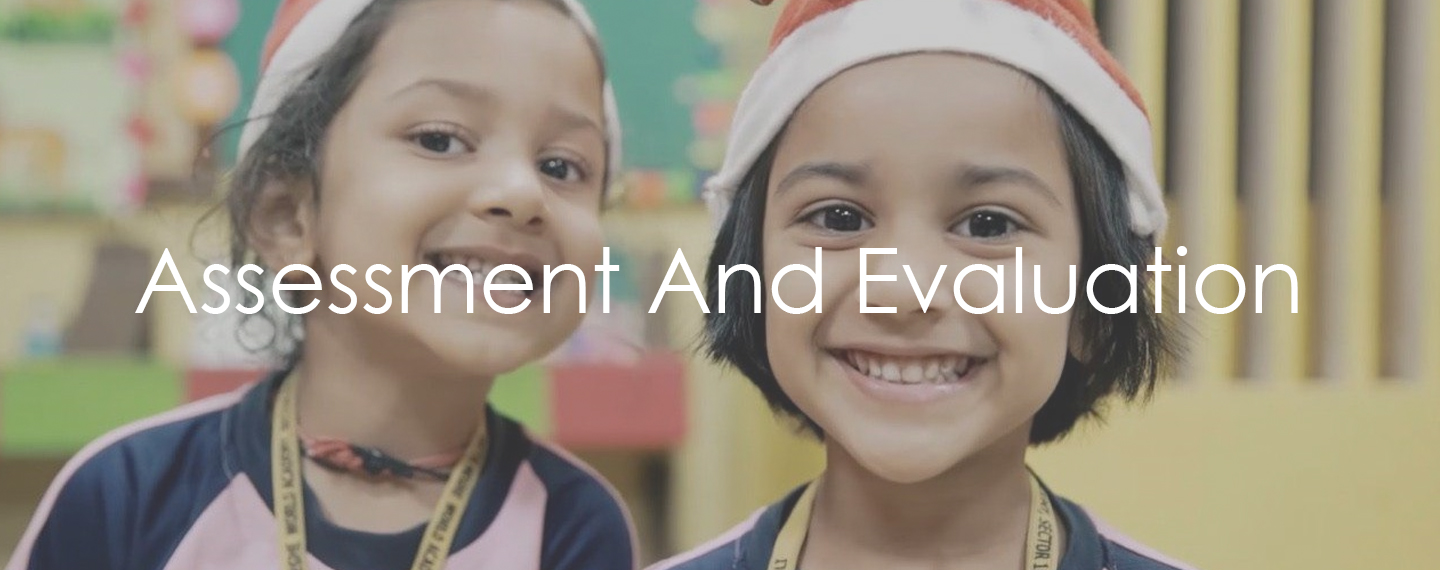
Continuous and Comprehensive Evaluation (CCE) as the name implies is a development process of assessment which emphasizes on two fold objectives i.e. continuity and evaluation on the one hand and assessment of broad range of instructional outcomes on the other.
Assessment And Evaluation Pattern Grade Wise
How it Helps?
- It helps in reducing the stress and anxiety which especially is seen among the age group of 13-15 years while the examination period.
- Reduction in drop-out rate due to reduced stress to the students
- Concept of learning introduced rather than following old method of teaching just to ensure passing the tests.
- The emphasis is more on conceptual clarification through experiential learning in the classroom
- It also helps to a great extent in personality development of each student
- It is expected to deliver a great health to any student since they are making huge effort towards physical fitness of student, mental alerts, and also help them to be emotionally balanced.
- Students also have focused approach towards developing their interests, hobbies and personalities.
- It also helps to students and parents to identify the course or subject to be chosen during the next class.
- It helps to equip the students with life skills i.e. creative and critical thinking skills, social and coping skills.
Assessment and Evaluation
- The “Continuous” aspect of CCE takes care of “Continual” evaluation
- Continual means assessment of students in the beginning of instructions (placement evaluation) and assessment during the instructional process (formative evaluation) done informally using multiple techniques of evaluation
- Periodicity means assessment of performance done frequently at the end of unit/term.
- The “Comprehensive” component of CCE takes care of assessment of all round development of the child’s personality. It includes assessment in scholastic as well as co-scholastic aspect include curricular areas or subjects specific areas, whereas co-scholastic aspects include life skills, co-curricular, attitudes and values.
- Assessments in scholastic areas are done informally and formally using multiple techniques of evaluation continuously and periodically. The diagnostic evaluation takes place at the end of unit / term. The causes of poor performance in some units are observed using tests. These are followed up with appropriate interventions followed by retesting.
- Assessment in co-scholastic areas is done using multiple techniques on the basis of identified criteria, while assessment in the life skills is done on the basis of indicators of assessment and checklists.
Function of CCE
- Continuous and Comprehensive Evolution identifies areas of aptitude and interest.
- It helps in making decision for future regarding choice of subject, course and career.
- It provides information / reports on the progress of students
- It provides child a realistic self-assessment of how he/she studies. It motivates children to develop good study habits, to correct errors, and to direct their activities towards achievement of desired goals.
- It helps the teacher to organize effective strategies. Continuous evaluation helps in regular assessment of learner’s progress & serves to diagnose weaknesses. It permits the teacher to ascertain an individual leaner’s strength and weakness.
Assessment Pattern
There are two patterns to conduct the assessments like below:
- Formative Assessment: It is a process used by a teacher to continuously monitor students’ progress in a non-threating and supportive environment.
- Summative Assessment: it is carried out at the end of course of instruction. It indicates and measures the amount of learning student has done in the school.
Features of Summative Pattern
- It is diagnostic and remedial
- Makes the provision for effective feedback
- Platform for active involvement of students in their own learning.
- Enables teachers to adjust teaching to take account of the result of assessment
- Recognizes the profound influence assessment has on the motivation and self-esteem of students.
- It helps students recognize their own mistake and overcome by learning the same very soon.
- Incorporate various learning styles into deciding what and how to teach.
- Encourage students to understand the eligibility of the submission of work and towards the judgment of the work.
Features of CCE
- The “Continuous” aspect of CCE takes care of “Continual” evaluation
- Continual means assessment of students in the beginning of instructions (placement evaluation) and assessment during the instructional process (formative evaluation) done informally using multiple techniques of evaluation
- Periodicity means assessment of performance done frequently at the end of unit/term.
- The “Comprehensive” component of CCE takes care of assessment of all round development of the child’s personality. It includes assessment in scholastic as well as co-scholastic aspect include curricular areas or subjects specific areas, whereas co-scholastic aspects include life skills, co-curricular, attitudes and values.
- Assessments in scholastic areas are done informally and formally using multiple techniques of evaluation continuously and periodically. The diagnostic evaluation takes place at the end of unit / term. The causes of poor performance in some units are observed using tests. These are followed up with appropriate interventions followed by retesting.
- Assessment in co-scholastic areas is done using multiple techniques on the basis of identified criteria, while assessment in the life skills is done on the basis of indicators of assessment and checklists.


 Curiosity is something that we all humans are born with. It is a drive that motivates us to lead our life. It is an inquisitiveness that initiates the process of being a lifelong learner. Whether it is a child or an adult it gives scope to everyone. Everyone is a born learner, only the way to explore the hidden facts of this world & its existence differs. In short we can say that it is an enthusiasm to explore, discover and figure things out. Paul Berg has very beautifully quoted the nurturing of curiosity and instinct to seek solution and its importance in education. Before understanding this quote it is significant to understand the actual meaning of education.
Curiosity is something that we all humans are born with. It is a drive that motivates us to lead our life. It is an inquisitiveness that initiates the process of being a lifelong learner. Whether it is a child or an adult it gives scope to everyone. Everyone is a born learner, only the way to explore the hidden facts of this world & its existence differs. In short we can say that it is an enthusiasm to explore, discover and figure things out. Paul Berg has very beautifully quoted the nurturing of curiosity and instinct to seek solution and its importance in education. Before understanding this quote it is significant to understand the actual meaning of education. Dr. Reshma Meghe is a shining beacon in the field of education and healthcare in India. Applauded and recognized in both the fields around the country, her quest for delivering high quality in each domain continues to prevail. She strongly believes in developing and delivering state of the art projects that will differentiate and sustain for years benefiting young India.
Dr. Reshma Meghe is a shining beacon in the field of education and healthcare in India. Applauded and recognized in both the fields around the country, her quest for delivering high quality in each domain continues to prevail. She strongly believes in developing and delivering state of the art projects that will differentiate and sustain for years benefiting young India.

